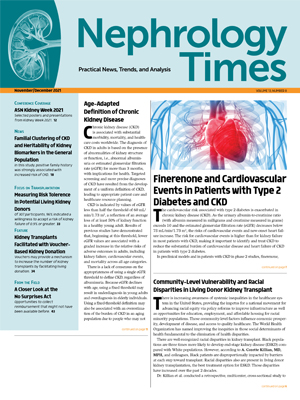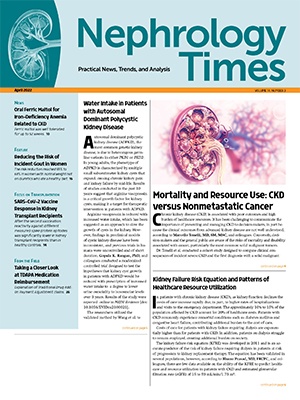
Among patients receiving peritoneal dialysis, inadequate fluid management is associated with a higher risk of cardiovascular morbidity and mortality. There may also be an association between inadequate fluid management and shortened peritoneal technique survival. Jennifer E. Flythe, MD, MPH, and colleagues conducted an analysis designed to examine the associations between fluid-related clinical factors and peritoneal dialysis technique failure within 1 year of treatment initiation.
Results of the analysis were reported during a virtual oral presentation at ASN Kidney Week 2021. The presentation was titled Fluid-Related Risk Factors of Peritoneal Dialysis Technique Failure.
The analysis included data on adult patients with end-stage kidney disease who were newly prescribed peritoneal dialysis for ≥120 days at Fresenius Kidney Care facilities between 2017 and 2019. Deidentified data were extracted from the Fresenius Kidney Care clinical data warehouse and evaluated within 120 days of initiation of treatment. The associations between fluid-related risk factors and peritoneal dialysis technique failure were assessed using crude and case-mix adjusted Cox regression models with competing risks (patient transfer to hemodialysis, death, and loss to follow-up).
The analysis included data on 15,854 patients on automated peritoneal dialysis (APD) and 1547 patients on manual peritoneal dialysis (CAPD). Among the APD group, mean age was 58 years and renal urea clearance (KRU) was 4.5 mL/min). In the CAPD group, mean age was 58 years and KRU was 4.8 mL/min. Percentages of patients with peritoneal dialysis technique survival ≥1 year were 53% of APD patients and 56% of CAPD patients.
All patients with urine volume ≤100 mL, systolic blood pressure >160 mmHg, history of cardiovascular events and hospitalizations, or weight change ≥2 kg between day 1 and day 120 of peritoneal dialysis treatment had a higher risk of 1-year peritoneal dialysis technique failure.
Significant patient-reported risk factors included shortness of breath (APD only) and edema (APD and CAPD). Patients with a weekly Kt/V >2 had half the risk of peritoneal dialysis attrition at 1 year.
In conclusion, the authors said, “APD and CAPD patients with fluid-related complaints (shortness of breath and edema), history of cardiovascular morbidity and hospitalizations, hypertension, or weight change ≥2 kg within 120 days of peritoneal dialysis initiation had a higher risk of technique failure within 1 year of peritoneal dialysis initiation.”
Funding for the analysis was provided by Fresenius Medical Care North America.
Source: Flythe JE, Ficociello L, Parameswaran V, et al. Fluid-related risk factors of peritoneal dialysis technique failure. Abstract of a presentation at the American Society of Nephrology virtual Kidney Week 2021 (Abstract FR-OR27), November 5, 2021.





 © 2025 Mashup Media, LLC, a Formedics Property. All Rights Reserved.
© 2025 Mashup Media, LLC, a Formedics Property. All Rights Reserved.